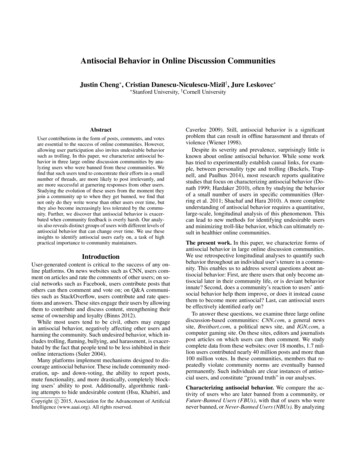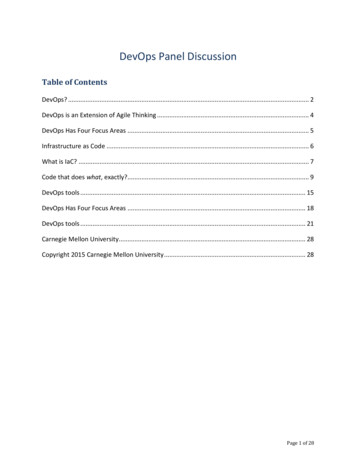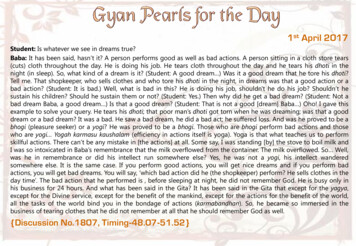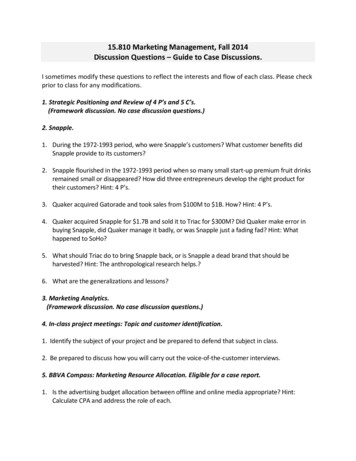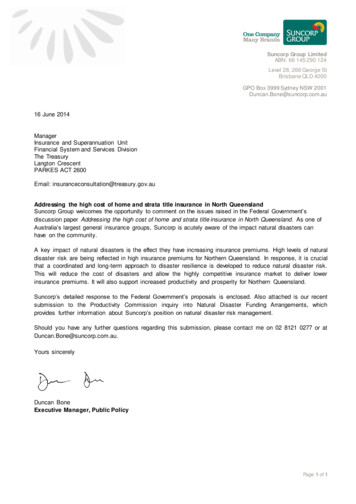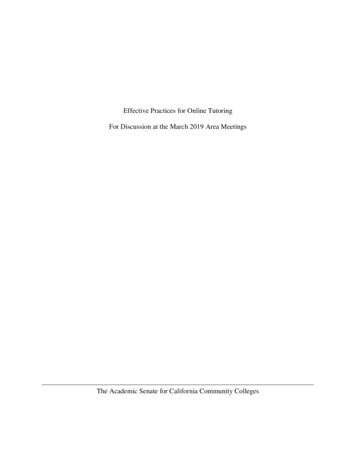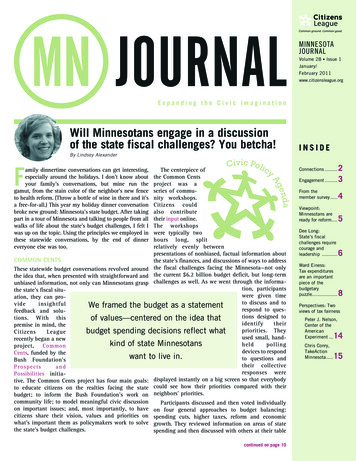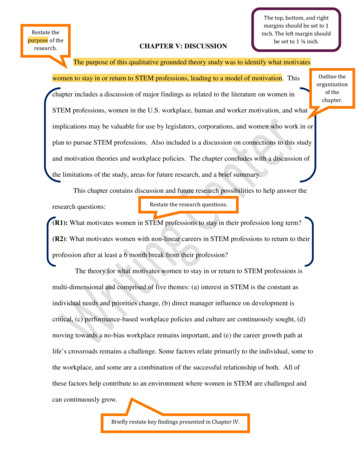
Transcription
Restate thepurpose of theresearch.CHAPTER V: DISCUSSIONThe top, bottom, and rightmargins should be set to 1inch. The left margin shouldbe set to 1 ¼ inch.The purpose of this qualitative grounded theory study was to identify what motivateswomen to stay in or return to STEM professions, leading to a model of motivation. Thischapter includes a discussion of major findings as related to the literature on women inSTEM professions, women in the U.S. workplace, human and worker motivation, and whatimplications may be valuable for use by legislators, corporations, and women who work in orplan to pursue STEM professions. Also included is a discussion on connections to this studyand motivation theories and workplace policies. The chapter concludes with a discussion ofthe limitations of the study, areas for future research, and a brief summary.This chapter contains discussion and future research possibilities to help answer theRestate the research questions.research questions:(R1): What motivates women in STEM professions to stay in their profession long term?(R2): What motivates women with non-linear careers in STEM professions to return to theirprofession after at least a 6 month break from their profession?The theory for what motivates women to stay in or return to STEM professions ismulti-dimensional and comprised of five themes: (a) interest in STEM is the constant asindividual needs and priorities change, (b) direct manager influence on development iscritical, (c) performance-based workplace policies and culture are continuously sought, (d)moving towards a no-bias workplace remains important, and (e) the career growth path atlife’s crossroads remains a challenge. Some factors relate primarily to the individual, some tothe workplace, and some are a combination of the successful relationship of both. All ofthese factors help contribute to an environment where women in STEM are challenged andcan continuously grow.Briefly restate key findings presented in Chapter IV.103Outline theorganizationof thechapter.
Include anoverview andinterpretation ofthe major findings.Interpretation of the FindingsWhile their career specialties, path, and experiences may include variation for eachindividual, each of the five common themes were prominent factors in motivating the womeninterviewed for this study, throughout their STEM journey. These themes have a dynamicdimension to them, as what is important to the individual changes over time. Each theme isdescribed in detail in the follow sections.Interest in STEM is the Constant as Individual Needs and Priorities ChangeThis study’s conclusion that career fit is essential to motivating women to stay inSTEM professions agrees with the historical literature that indicates career fit is a primarycontributor and a good predictor of persistence (Giles, 2009; Jones et al., 2010; Matusovich,2010). Career fit relates solely to an individual’s interest. While one can expose someone toa profession, one cannot force them to like a specific job or career. Buse and Bilimonia(2013) concluded that among the women who had left the engineering profession, someexpressed having been pushed into engineering. While some participants did admit beingexposed to STEM professions by someone else, their involvement was their own idea. Allparticipants described a genuine love for their math- and science-based careers. Participantscited enjoyment of the overall challenge of their chosen professions, often described asenjoying the problem solving, achievement, continuous learning, creativity, and the variety intheir work.In this study, women emphasized family or community priorities. Even those womenin the study who did not have children, expressed emphasis on their life outside of work,particularly as they matured into their careers. Throughout most interviews, the womenexpressed their career choices in terms of sacrifices or balanced. While some women104
admitted to some imbalances during times of change in their life, participants felt balancedand satisfied overall.There was no difference in what motivated women with linear careers or nonlinearcareers to stay in STEM professions. The women with nonlinear careers expressedsatisfaction with their job opportunities, similar to that expressed from women in linearcareers. The women in nonlinear careers came back, because they loved their field of work,which was again, one of the primary reasons women in linear careers stayed long-term.Tip: In APAstyle, you canseparateitems in aseries usinglowercaseletters withinparentheses.Direct Manager Influence on Development is CriticalWhile all participants expressed ownership in their career paths, across all professionsand across all age demographics, participants referenced the direct manager as an importantpartnership throughout the career journey. Specifically, the results of this study includedthree sentiments: (a) my manager respects my capabilities, (b) he or she understands myindividual needs, and (c) my manager values my work. Underlying all of the sentiments wasan inference to trust in the employee-manager and manager-employee relationshipThe emphasis on the direct manager in this study is consistent with what is in theliterature regarding studies related to women in STEM. Marques (2011) made reference tothe importance of the direct manager regarding how managers assist with building areputation of confidence and how direct managers are key influences in future growthopportunities. This study’s conclusion emphasizes the importance for both the worker tocommunicate their individual needs to the direct manager and for the direct manager tounderstand that needs are unique to the individual. Understanding the individual’s needs,too, is in line with the literature that motivation varies according to each individual. It isimportant for organizations to focus on the intrinsic motivators that they can help shape,rather than just the extrinsic motivators that they can institute (Furnham et al., 2009).105Throughoutthis section,discuss yourfindings inthe contextof theliterature.
Tip: Whencitingmultipleresources ina citation,put them inalphabeticalorder.One of the noticeable differences in the results of this study, as compared to existingstudies, was the emphasis on direct managers versus the emphasis on mentors previouslywritten about in the literature (Glass & Minnotte, 2010; Kerr et al., 2012; Marques, 2011;McLaren, 2009; Powell, 1992; Preston, 2004). Mentors were not overwhelmingly positionedas drivers of motivation in this study. There were some examples in this study whereparticipants cited peer groups, mentors, or company-sponsored mentoring programs as beinghelpful to them. This study is consistent with the literature that discusses the impact ofmentors as helping, but not necessarily critical in keeping women in STEM fields (Glass &Minnotte, 2010; Kerr et al., 2012; Marques, 2011; McLaren, 2009; Powell, 1992; Preston,2004). While the mentors and programs cited by participants in this study certainly helpedmanage day-to-day challenges, the mentors were not often cited as sponsors that helped themmove towards their career goals or keeping them in STEM. Their direct managers weregenerally cited as that key sponsor in helping them reach their goals.Motivators change over time. It is important for managers to know their employeesas individuals, to be able to understand what motivates them (Davila & Pina-Ramirez, 2014).Katarzyna and Dagmara (2012) referred to the manager-employee trust relationship as onethat hinges fundamentally that the manager is in a position to make decisions that impactemployees. While an employee can demonstrate competence, and express a desire to movein a certain direction, within that particular company, the direct manager often has the finalinput into performance evaluations and career growth decisions (Katarzyna & Dagmara,2012). Conversely, examining the employee-manager relationship through the lens of amanager, the manager has a vested interest in building the reputation and competence of his106
or her employees, as their work is a reflection of the manager’s (Katarzyna & Dagmara,2012).Performance-Based Workplace Policies and Culture are Continuously SoughtPerformance-based policies and culture are more satisfiers than motivators,foundational to fostering an environment for these four motivators. This study’s resultsemphasized that career desires and individual needs change over time, and thereforemotivation to stay in or return to STEM professions may have varying points of emphasis.This multi-dimensional framework depends on the balance an individual is trying to achieveduring that life stage or career stage and the options available to them in the workplace.The literature emphasizes the importance of trust in the employee-employerrelationship regarding motivation, particularly when related to fair wage (Latham, 2009).Historically, women leave STEM professions because of the wage gaps compared with theirmale counterparts (Hunt, 2010). Salary inequity continues to be prevalent in the UnitedStates (Brawner et al., 2012; Giles et al., 2009; Lincoln et al., 2012; Powell, 1992; Preston,2004; Rhea, 1996). Both full-time and part-time participants cited salary as a motivator forstaying in the profession. Several cited salary as having more importance as they matured intheir career, which emphasizes that salary is important in retaining women in STEMprofessions.Historically, the perception also included that workplace policies are gender-biased,including workplace incentives (Pas et al., 2014; Smith et al., 2012). The participants in thisstudy agreed that generally their workplaces had good work-life balance policies, offeringthem flexibility in managing their time at work and time at home. One of the most-citedstructural barriers in the workplace was effective policies that promoted work-life balance107
Tip: Avoid anthropomorphism. In this sentence, it would be better to say: The results of this study alignwith For help, see the guide on anthropomorphism.(Glass & Minnotte, 2010; Kerr et al., 2012; Powell, 1992; Preston, 2004). This study isinconclusive as to whether or not policies are a barrier. Work-life balance policies were notcited as a motivator in this study because most participants attributed the flexible workplaceas a part of the culture, rather than as instituted by a policy.The results of this study would agree with the literature regarding the importance offlexible work policies. Friedman and Lackey (1991) suggested that a work schedule thatallows more control over their lives is a motivator for women to persist in STEM professions.Flexible work arrangements were highly valued by the women who participated in this study,which is consistent with conclusions found by Catalyst (Beninger & Carter, 2013). Thewomen in this study indicated downsizing their aspirations at times in their career, even iftheir workplace policies afforded them a flexible work arrangement. This finding may beindicative that the workplace will employ women at comparable wages with flexiblearrangements, but not target them for advancement opportunities.One interesting difference in flexibility in the women interviewed for this study wasthe level of flexibility that the women had. Some defined flexibility as being able to leavethe office for a child’s school function. Others described flexibility in terms of a restructuredwork week beyond the traditional 9-5. Other participants defined flexibility as working fromhome. There is no standard flexibility. Within the United States, a minimum wage exists, aswell as maternity leave. If flexibility is so critical to creating work-life balance, perhaps it istime to do something different with how it is approached for every worker, making theworkplace a step closer to humanizing on a more consistent scale.Moving Towards a No-Bias Workplace Remains ImportantIn previous literature, commonly cited barriers related to organizational culture andwomen progressing in STEM careers included workplace recognition barriers (Glass &108
Minnotte, 2010; Lincoln et al., 2012; Thilmany, 2010); workplace culture barriers (Beddoes& Borrego, 2011; Cheryan, 2012; Kerr et al., 2012; Marques, 2011) and other maledominated workforce barriers (Fouad, Singh, Fitzpatrick, & Liu, 2012; Thilmany, 2008).The participants in this study did not perceive the male-dominated workforce professions as amodern day barrier for STEM. Previous literature cited women feeling as if they were tokensof diversity on leadership teams (Glass & Minnotte, 2010; Lincoln et al., 2012).Previous studies undertaken referred to lack of invitations to informal networks in theworkplace (Glass & Minnotte, 2010; Kerr et al., 2012). Many women who participated inthis study acknowledged that they were a noticeable minority. However, in contrast toprevious literature, the male majority was not cited as a barrier and there was no dominantsuggestion that women felt like they were diversity tokens, or felt left out of networks in theContinue to connect the findingsto the existing literature.modern day STEM workplace.Workplace recognition, despite not being positioned by the women interviewed inthis study as being unequal, was certainly still seen as an uphill challenge for some women attimes in their career in terms of juggling family priorities and finding satisfying roles andgrowth opportunities. Having credibility is based on another’s judgment of your capabilities.As the reputation is still heavily based on a small few (direct manager, direct leadershipteams) and not positioned as the workplace overall, it seems like there could still be a bias forwomen in STEM professions regarding growth opportunities.The participants in this study did not project the inflexible work culture positioned inthe literature. Further, the participants acknowledged some long work weeks but theparticipants did not see these times as barriers, but part of the payback they make to thecompany for the flexibility they have to leave work or work from home when their personal109
life requires more time (Tomlinson et al., 2005). References included workplace culture ashaving a higher influence than workplace policies. The women in this study had mixedthoughts on workplace culture, particularly those in large organizations that noted a dislikefor politics.Because some of the hostile environment behaviors still exist in pockets, it isreasonable to suggest that the modern day STEM workplace is not completely free fromremnants of the past. The positive step-changes towards performance-based policies andculture seem to be evidence of broad organization changes that help to motivate women tostay in STEM professions. What remains unclear is whether or not a stigma related togrowth opportunities continues to be perpetuated because of implicit bias of the still typicalmale-dominated STEM culture.The Career Growth Path at Life’s Crossroads Remains a ChallengeThe women in this study had various career paths, very unique to the individual. Asthis study verified, women in STEM seek a challenge, enjoy learning, and enjoy doingsomething new. In other words, they like to continuously grow. Career growth motivationfor the women in STEM in this study was not just described as a linear trajectory up thecorporate hierarchy, particularly when life event importance outweighed professionaladvancement as a personal priority for them in their own individual circumstance.Freidman and Greenhaus (2000) called these career choices leaning towards havingmuch of it all where women make choices that had a career sacrifice element to it at aparticular life stage. Having much of it all, or having it all, perhaps not always at the sametime is a similar sentiment to what the women interviewed in this study expressed. Womenstill want to be challenged and still have goals to achieve in their career in STEM when they110
marry and have children. Women in STEM expect that they will be seen first and foremostas a professional in the lens of their managers, co-workers, and clients.Throughout their career journey stories, the women in this study largely shared theircareer growth opportunities through a positive lens. Many directly spoke about, or implied,that they had several occasions where the choices along their career path had a work-lifebalance component to consider. Some participants in this study spoke about career choicesthat they made to reshape their day or role when having children, where the roles helpedthem continue towards a steadily upward trajectory career path. For example, one participantworked 4 days, 10 hours a week. Other participants conversely spoke about the consciouschoices of taking roles that were career growth sacrifices made in lieu of prioritizing familyfirst. This outcome was especially the sentiment expressed by women who took part-timeroles.Women in this study voiced that they had growth opportunities, but not all weremotivated to be on a career fast track. Some women were. Many participantsenthusiastically heralded growth opportunities provided through lateral moves as beneficialto their growth and development. Some women indicated that part-time work was critical toTip: Useitalics whenappropriate.For help, seethis guide onitalics.them pursuing their careers. However, part-time work is not rewarded with growthopportunities, according to the women in this study.The STEM workforce is not unique with regards to work-life balance. Researchersrefer to this dynamic as the work-family conflict (Kanter, 1997; Sperling, 2011). Kanter(1997) suggested that the workplace had to change the worker-employee relationship as thepost-industrial society emerged in America. All STEM professionals in this study citedconscious changes that they made to improve their own work-family conflict, particularly111
during periods of change in their careers. While many of the women cited changes madewhen they had children, some cited their individual interests outside of work. Participatingin horse riding, golf, travel, volunteering, and other out-of-work activities were cited asenjoyable activities and in some cases positioned as stress management activities that theirwork day flexibility helped enable.Implications for Theory and ResearchChapter II included descriptions of several motivation models. These modelsincluded Maslow’s hierarchy of needs, Herzberg’s two-factor theory, goal setting theory,equity theory, and self-efficacy theory. How the motivation model discovered in this studyfits with these models is discussed in the following sections.Maslow’s Hierarchy of NeedsDiscuss how the results connect to theconceptual/theoretical framework.Maslow’s (1964) theory of a hierarchy of needs includes the suggestion that onlyupon fulfilling the lower needs of security, safety, and belonging, can a person realizegrowth, or self-actualization. In this study, a good salary and good working conditions in aperformance-based culture and rewards and recognition, most closely linked to the securityand safety layers of the Maslow hierarchy. The results of this study aligned with Maslow’sTheory that certain basic needs are important. However, these needs are not necessarily in ahierarchy with belonging and growth. The results of this study confirmed that the motivationhierarchy is not rigid.The motivations of individuals for belonging are important, as this study emphasizesthe importance of women’s reputation and credibility, but belonging is not necessarily aprerequisite for persistence in growth in STEM professions. The women in STEMprofessions interviewed in this study seemed to grow through various periods of self-112
actualization and regrowth in their careers, based on their desires and expectations ofthemselves as they grew as a person. The cycle of continuous growth is a strong componentof what keeps women in STEM motivated, consistent with Maslow’s theory where peoplecont
Flexible work arrangements were highly valued by the women who participated in this study, which is consistent with conclusions found by Catalyst (Beninger & Carter, 2013). The women in this study indicated downsizing their aspirations at times in their career, even if their workplace policies afforded them a flexible work arrangement.
